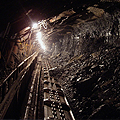DON’T LET YOUR MONETARY INVESTMENT GO TO WASTE: CHOOSE ONLY THE BEST MINING EQUIPMENT
October 24, 2016
An unsettling decline in geological commodities may cause a stir in some, but expert mining speculators and hardcore management teams know the truth. There’s still mountains of underground resources below our feet. It’s just that it now takes more effort and more advanced equipment to reach and excavate the deeply recessed mineral reserves. In service of these industrious engineers, monetary investments won’t go to waste, not when the best mining equipment is sourced at all times.
CHOOSE ONLY THE BEST MINING EQUIPMENT
A high-tech enterprise leverages the latest engineering doctrines before a single crusher or screening solution leaves the draughting board. The goal is to push the technological envelope and supply a mining partner with pertinent feature sets, so the design process rewinds all the way back to the materials selected and functions required before engaging the manufacturing process. Sometimes this systematic conception-to-production methodology involves nothing more than identifying an impact resistant alloy that can withstand high-volume aggregate flows, but, more often than not, the manufacturing framework integrates more sophisticated elements, including plastics.
BEYOND ALLOY-REINFORCED FRAMEWORK
A manufacturing agency that focuses only on the structural demands of a mining complex is destined to become an outdated supplier whose reputation will be eclipsed by visionary mining equipment sources. The better equipment uses the finest alloys, as touched upon earlier, but these metals are layered with superior engineering plastics so that the armoured resilience of the gear is bolstered by a shock-absorbent elasticity factor. Now, between the new classes of robust polymers and the strengthened steels mounted on the best mining gear, well, the advantages are plain to see. Downtime is eliminated. Likewise, advanced lubrication solutions reinforce the situation by minimising maintenance periods and truly letting slip the constricting leashes that once held back geologically-toughened machinery.
OPTIMISED WITH SUPPLEMENTARY ATTRIBUTES
Back at the blueprint stage, diligent designers highlight material design principles, but it takes more than a tough frame to take full advantage of a monetary investment. Supplementary parts and subsystem assemblages are equally well manufactured at the design stage. This means screening decks, conveyor pulleys, lubricated drive shafts, high-quality rolling bearings, and reciprocating motors all need to be every bit as functional and well-equipped as any of the armored bodywork castings used in the mine.
In conclusion, the manufacturing expertise that guides the production of fine machinery, as destined for a mine or quarry, is a highly focused craft, but that focus moves to accommodate every component, every subsystem and fastener, all so that the assembled machinery can be classed as the best mining equipment available in today’s engineering market.
Optimized by: Netwizard SEO


